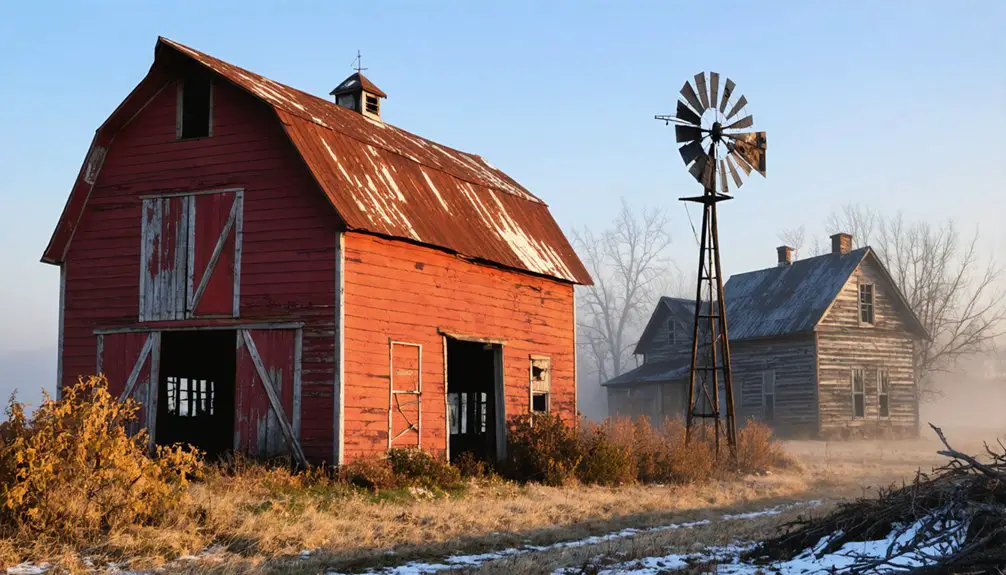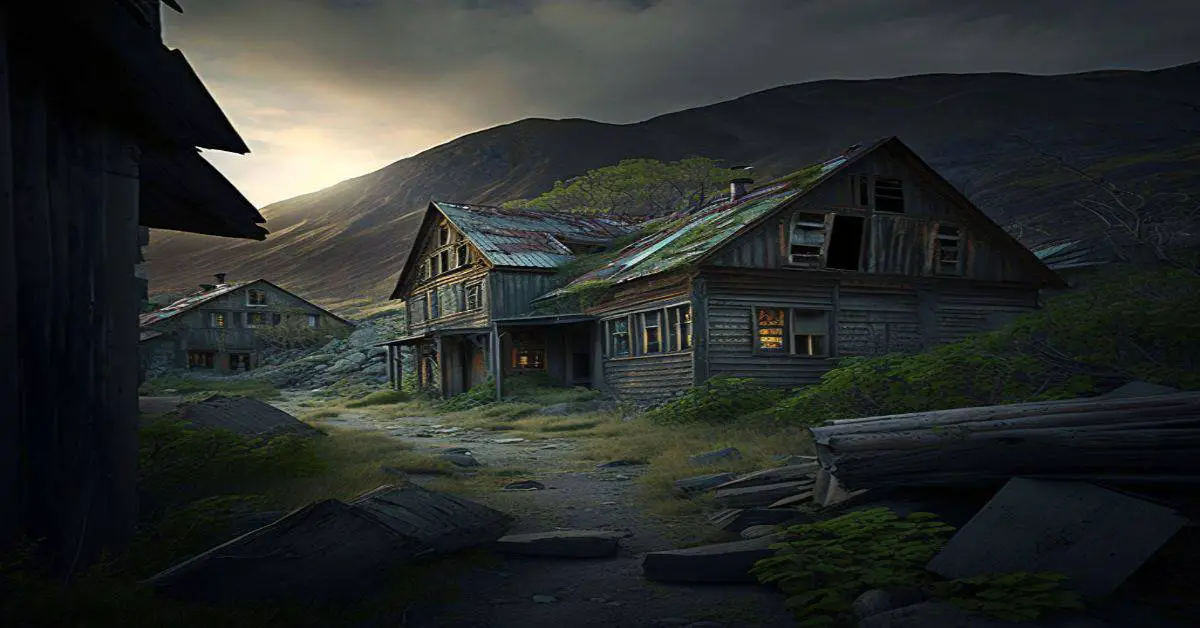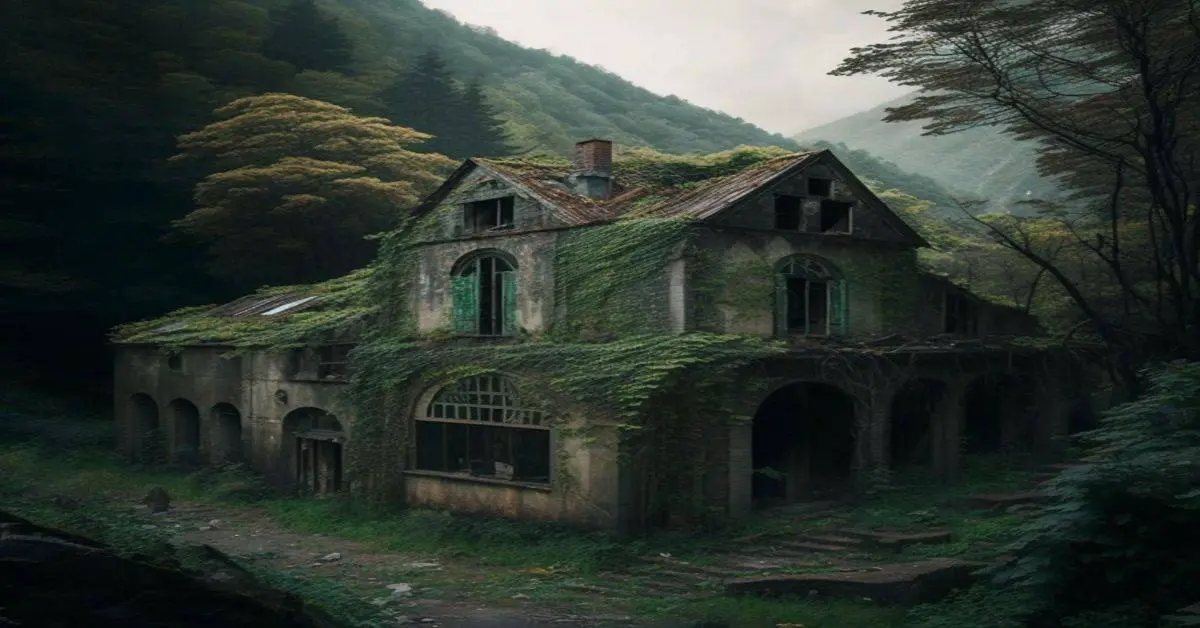You’ll find Damon as a former lumber settlement established in 1878 in Foster Township, Ogemaw County, Michigan. Named after George G. Damon of Cutting & Damon lumber firm, the town quickly grew to include a hotel, warehouse, post office, and general store. At its peak in the 1880s, the local mill produced 8 million board feet of lumber annually. After logging declined in the early 1900s, Damon transformed into one of Michigan’s most fascinating ghost towns, with mysterious tales still echoing through its abandoned structures.
Key Takeaways
- Damon was established in 1878 as a lumber settlement in Foster Township, Michigan, thriving until timber resources depleted in the early 1900s.
- The town’s abandonment began with the post office closure in 1907, marking its transformation from bustling lumber community to ghost town.
- Historic structures remain, including a general store and the allegedly haunted Damon Cemetery with grave markers from the 1800s.
- Author James Oliver Curwood immortalized Damon in his 1930 novel “Green Timber,” documenting the town’s decline after visiting in 1911.
- At its peak, Damon’s lumber mill produced 8 million board feet annually, supporting a community with hotels, stores, and essential services.
The Rise of a Lumber Town (1878-1880)
In 1878, a small lumber settlement called Damon emerged in Foster Township, Ogemaw County, about 10 miles north of West Branch, Michigan. Named after George G. Damon, partner in the Cutting & Damon lumber firm, the town quickly established itself as a key player in Michigan’s booming timber industry.
You’d have found logging techniques focused on harvesting the abundant white pine, with workers flooding into the area to staff lumber camps and mills. The enterprising Davison Brothers established a major presence, building a hotel, large warehouse, and general store.
The community dynamics evolved rapidly as essential services took shape. By 1880, Damon had secured official postal services, while boarding houses, a hotel, and general stores sprouted up to serve the growing population. The town’s legacy later inspired author James Oliver Curwood to feature it in his novel Green Timber.
As Damon’s population surged, vital services emerged to meet growing needs – from postal offices to hotels and general stores.
The settlement’s strategic location amid rich timber resources positioned it perfectly for the lumber rush sweeping across northern Michigan.
Life in Damon’s Golden Years
As Damon’s lumber operations hit their stride in the early 1880s, the town evolved into a bustling community centered around its sawmill operations.
You’d find lumberjack families settling into daily routines, with children attending the local school while their fathers worked in the surrounding forests. The town’s hotel provided lodging for visiting workers, while the general store supplied essential goods to residents.
Like Port Sheldon’s initial growth, the community saw rapid development with the construction of pre-built homes. Community events would’ve revolved around the rhythms of lumber work, with the post office and general store serving as natural gathering spots.
You can imagine the town’s liveliness during this period, as captured in James Oliver Curwood’s visits and writings. The depot buzzed with activity, and the sawmill’s constant operation provided steady employment that kept the town’s economy humming through the late 1800s. Today, only a dirt road intersection remains where the vibrant downtown once stood.
Economic Foundations and Commerce
The economic foundation of Damon rested almost entirely on its lumber trade, established by George Damon’s firm in 1878. At its peak, the local mill churned out an impressive 8 million board feet of lumber annually, with 75 horse teams hauling logs through the winter months.
You’d find the town’s economic interdependence evident in its commercial infrastructure. A general store and hotel served the logging community, while a post office operated from 1880 to 1907, briefly reopening until 1915. Like many ghost towns that followed boom-bust cycles, Damon’s prosperity was tied directly to its single resource industry.
Workers lived in temporary camps, supported by regular supply runs from town. Local farmers rented their horse teams to lumber operations, creating crucial economic partnerships. Today, only a former warehouse and scattered ruins remain as testament to the once-bustling logging community.
The town’s strategic location, 10 miles north of West Branch, positioned it perfectly for timber distribution throughout Ogemaw County.
From Boom to Abandonment
Once George Damon’s logging firm established operations in 1878, the town of Damon quickly transformed from wilderness to bustling lumber settlement.
Like the Keweenaw Peninsula’s copper mining towns, Damon’s fate was tied to resource extraction and eventual depletion.
Within just a few years, you’d have found a thriving community complete with:
- A post office serving the growing population by 1880
- A hotel housing the influx of lumberjacks and travelers
- A schoolhouse educating workers’ children
The town’s prime location just west of Rose City made it an ideal spot for the lumber industry to flourish.
But by the early 1900s, you would’ve witnessed the inevitable logging decline as local forests became depleted.
Community outmigration followed swiftly, marked by the post office’s closure in 1907, brief reopening in 1911, and final shutdown in 1915.
The exodus continued until 1925, when all buildings except the general store had vanished.
Today, you’ll find only scattered ruins in Ogemaw State Forest, with the town’s cemetery standing as a silent witness to Damon’s boom-and-bust story.
Notable Buildings and Landmarks
As you explore Damon’s remaining structures, you’ll find the historic general store standing as one of the few surviving buildings from the town’s logging heyday.
The post office, which operated from 1880 to 1907 and briefly reopened from 1911 to 1915, served as the community’s essential communication hub during its peak years. The town also featured an oil house that stored fuel and kerosene for the community.
A half mile south of the former downtown intersection lies Damon Cemetery, featuring wooden and stone markers dating to the 1800s and known locally as “Michigan’s Most Haunted Cemetery.”
Post Office and Store
Located at the heart of Damon’s commercial district, a post office and general store served as essential community institutions from 1880 until the town’s decline.
Similar to Port Sheldon’s early development that included a general store and other amenities, these buildings were central to the town’s initial growth.
The post office significance stemmed from its role in connecting the logging community to the outside world, while the general store legacy lives on through its still-standing structure within Ogemaw State Forest.
You’ll find these buildings reflected typical rural Michigan construction of the late 1800s, with practical wood-frame designs suited for a bustling timber town.
Their importance to daily life included:
- Supporting logging operations through communication and supplies
- Providing a central gathering place for residents and workers
- Offering essential goods and postal services that kept the remote community functioning
Today, these weathered structures stand as the last physical reminders of Damon’s once-thriving logging community.
Historic Hotel Remains
The historic hotel stood as a prominent landmark in Damon during the late 1800s lumber boom, serving as both lodging for travelers and a social hub for the logging community.
Built with local timber, the hotel’s architecture followed traditional wood-frame construction typical of Michigan’s logging towns, featuring multiple rooms, a lobby, and dining areas to accommodate the steady flow of workers and businessmen.
Today, you’ll find little trace of this once-bustling establishment.
The hotel site now lies empty and overgrown, with only cellar depressions and scattered debris marking its former location.
While the building itself is gone, its historical significance lives on through local records and accounts, representing a time when Damon thrived as an essential stopover in Michigan’s logging region.
Pioneer Cemetery Site
Situated half a mile south of Damon’s former downtown area, the Pioneer Cemetery stands as one of the last physical remnants of this once-thriving lumber town.
Dating back to the late 1800s, this historic burial ground features weathered tombstones, including unique wooden markers that reflect the modest means of early settlers.
For those interested in cemetery preservation and historical significance, you’ll discover:
- Unmarked dirt roads leading to this hidden site, requiring GPS coordinates for navigation
- Original wooden and stone grave markers from Michigan’s lumber boom era, though many inscriptions have faded
- Both marked and unmarked graves that tell the story of Damon’s pioneer families and lumber workers
The cemetery remains vulnerable to natural decay, making it an important yet fragile connection to northern Michigan’s ghost town heritage.
Literary Connections and Cultural Impact
If you visit Damon today, you’ll find a ghost town immortalized in James Oliver Curwood’s 1930 novel *Green Timber*, which captured the area’s once-thriving lumber industry after his 1911 visit when he dubbed it the “Lost City of Damon.”
The town’s compelling history of boom and bust has drawn many regional writers to document its story through articles, blogs, and historical accounts. Damon’s legacy lives on through these literary works, which preserve the cultural memory of Michigan’s lumber era while adding to the mystique of this vanished community.
Curwood’s Green Timber Connection
Literary giant James Oliver Curwood immortalized Damon’s history through his posthumously published novel *Green Timber*, drawing direct inspiration from his 1911 visit to this Michigan lumber town.
His secretary, Dorothea A. Bryant, completed the work after his death, preserving Curwood’s authentic portrayal of lumber-era Michigan.
You’ll discover three key elements of Curwood’s inspiration from Damon:
- The town’s boom-and-bust cycle directly influenced his story “The Lost City of Damon”
- The general store and remaining structures served as tangible references for his literary setting
- The timeline of Damon’s decline (post office closure 1907/1911-1915) framed his narrative’s historical context
This literary legacy guarantees Damon’s story lives on, even as the physical town has faded into Michigan’s wilderness.
Local Writers Draw Inspiration
Beyond James Oliver Curwood‘s influential portrayal, Damon’s ghostly remnants continue inspiring generations of writers who’ve found creative sustenance in this vanished lumber town.
Contemporary poets like Matthew Borczon draw local inspiration from Damon’s abandoned landscapes, weaving themes of nature’s reclamation into their works. You’ll find these literary reflections preserved through oral histories and regional authors who document the town’s transformation from a bustling lumber hub to a silent memorial of Michigan’s industrial past.
The Damon Cemetery serves as a tangible anchor for writers exploring themes of memory and displacement, while the surrounding forest-reclaimed ruins spark philosophical contemplations about humanity’s temporal presence.
Through their words, these authors help preserve Damon’s legacy, contributing to a rich tapestry of regional storytelling that resonates with modern readers seeking connection to Michigan’s vanished communities.
Preserving Lumber Era Stories
Through dedicated preservation efforts, Michigan’s lumber era stories find permanent homes in local museums and heritage centers, where artifacts and structures from Damon’s heyday illuminate life during the industry’s peak.
You’ll discover how oral histories and folklore preservation efforts have saved essential cultural elements of Michigan’s lumber heritage.
Local organizations continue protecting these narratives through:
- Museum exhibits showcasing log marks, tools, and transport implements
- Educational programs featuring lumber camp life and river-driving techniques
- Literary collections including James Oliver Curwood’s “Green Timber,” which immortalized Damon in fiction
These preservation initiatives guarantee that future generations can connect with Michigan’s rich lumber heritage, from the technical aspects of logging operations to the personal stories of the families who shaped the region’s development through their work in the timber industry.
What Remains Today: A Ghost Town Legacy
Remnants of Damon’s once-thriving lumber community dot the landscape of Michigan’s Ogemaw County today.
You’ll find the old General Store building still standing, along with a few private houses and the former Post Office site, offering prime opportunities for ghost town exploration.
About half a mile south of the town center, the Damon Cemetery holds wooden grave markers and tombstones dating back to the 1800s.
The site’s location within Ogemaw State Forest adds to its remote character, with dirt roads and natural terrain making it challenging to locate.
Hidden deep within Ogemaw State Forest, Damon’s secluded remains challenge explorers navigating its rugged backwoods paths.
While forest regrowth has reclaimed much of the original townsite, historical preservation efforts focus on protecting the cemetery’s fragile markers.
If you’re visiting, you’ll need GPS coordinates, as modern maps rarely show Damon’s location.
Frequently Asked Questions
Are There Any Documented Paranormal Activities or Ghost Sightings in Damon?
You won’t find verified ghost encounters or paranormal investigations in Damon. Despite its ghost town status, there’s no documented evidence of supernatural activity in this former lumber town’s remains.
What Happened to the Original Residents After Leaving Damon?
Like scattered seeds in the wind, you’d find these displaced workers followed migration patterns toward urban centers or timber regions, though most resident legacies were lost as families independently sought new opportunities.
Can Visitors Legally Explore the Remaining Structures Today?
You’ll find no explicit exploration rules preventing access, but since structures sit on state forest land, follow general visitor guidelines: avoid entering unsafe buildings and respect historic sites.
Were There Any Major Fires or Disasters During Damon’s Active Years?
You won’t find any major fire incidents or disaster impacts recorded during this period – historical records show the town’s eventual abandonment came from economic decline and timber depletion, not catastrophic events.
Did Native American Communities Have Settlements in the Area Before Damon?
You’ll find Native tribes like the Potawatomi, Ojibwe, and Odawa maintained historical settlements in this area, establishing seasonal camps near waterways and fertile lands for hunting, fishing, and gathering resources.
References
- https://witl.com/one-of-michigans-first-ghost-towns/
- https://lostinmichigan.net/the-ghost-town-of-damon/
- https://kalamazoocountry.com/explore-the-lost-town-of-damon-michigan/
- https://99wfmk.com/damon-michigan-cemetery/
- https://www.waterwinterwonderland.com/namedplacedetail.aspx?id=6705&type=12
- https://msaf.forest.mtu.edu/ForestInfo/MSUElibrary/LumberingInMichigan.PDF
- https://wbckfm.com/lumber-camps/
- https://www.nps.gov/slbe/learn/historyculture/ghosttowns.htm
- https://historycollection.com/ghost-town-boom-bust-instant-cities-that-vanished/
- https://www.awesomemitten.com/ghost-towns-in-michigan/


